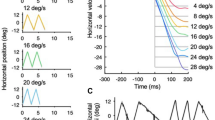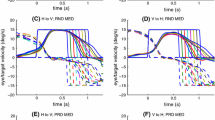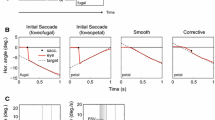Abstract
It has been established that repeated presentation of a transient target motion stimulus such as a constant- velocity ramp leads to the build up of steady state (SS), anticipatory smooth pursuit eye movements after two or three presentations. Each SS response is then composed of the anticipatory component of nonvisual origin, a visual component associated with the stimulus presentation and another nonvisual component that represents the decay of the response after extinction of the stimulus. Here we investigated the interactions that occur when each motion stimulus was itself a sequence containing more than one ramp component. Ramp components had a velocity of 15°/s or 30°/s to left or right and were separated by gaps of 200 ms duration. In an initial experiment, responses to 2-ramp stimuli were examined and compared with responses to the single-ramp stimuli from which they were constituted. We present evidence that the anticipatory, nonvisual components of the double-ramp response result from the linear summation of the nonvisual components of the responses to the constituent single-ramp components. In a 2nd experiment, we examined responses to a wide variety of 4-ramp sequences and again found evidence that, in the SS, the responses were formed from the linear summation of the constituent single-ramp components. Regression analysis performed on the velocity at onset of each ramp component indicated that this nonvisual part of the response was predictive of the upcoming ramp component. To confirm this, unexpected changes were introduced into single ramp components of the 4-ramp sequence after at least five prior presentations of the sequence had allowed a SS response to be established. Subjects continued to initiate a response to the modified component that was appropriate in velocity and direction for the corresponding part of the previous sequence and inappropriate for the newly modified stimulus. This preprogrammed response persisted unmodified for more than 170 ms after onset of the modified ramp component. In contrast, in the second presentation of the new sequence, the anticipatory component of the response was highly correlated with the SS response of the new sequence, but not with that of the prior sequence, showing that the preprogrammed response had been modified very rapidly. Similar behaviour was observed whichever of the 4-ramp components was modified, indicating that the velocity and direction of the anticipatory response to each component had been preprogrammed. The results suggest that velocity information related to at least four elements of a sequence can be temporarily stored and subsequently released with appropriate temporal order to form an anticipatory response throughout the whole sequence.
Similar content being viewed by others
Author information
Authors and Affiliations
Corresponding author
Rights and permissions
About this article
Cite this article
Barnes, G.R., Schmid, A.M. Sequence learning in human ocular smooth pursuit. Exp Brain Res 144, 322–335 (2002). https://doi.org/10.1007/s00221-002-1050-8
Received:
Accepted:
Published:
Issue Date:
DOI: https://doi.org/10.1007/s00221-002-1050-8




